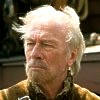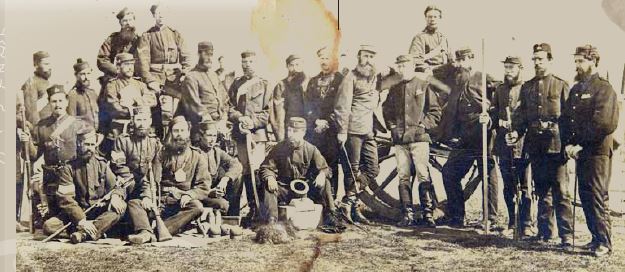Major-Surgeon Arthur Russel VC MD


The third son of one of the richest and most influential families in all the United Kingdom Arthur Russell could have slipped into a rather unfathomable life of luxury. Instead he dedicated his life to bettering the lot of his fellow man. Firstly by graduating medical school and when a prestigious practice on Harley Street beckoned he took up the post of assistant surgeon with the 65th (2nd Yorkshire, North Riding) Regiment of Foot.
The regiment were on the move again in 1855. The 65th sailed to New South Wales from Woolwich, England on the vessel "Java" on May 18th 1856, with Headquarters and 513 other ranks. The "Java took 138 days sailing via Hobart then to Sydney where it arrived on Oct 14th 1856. It then sailed to Kororareka in the Bay of Islands arriving on Nov 19th and then on to Auckland arriving Nov 27th 1856, Detachments were stationed in Auckland. Some were sent on the vessel "Driver" to Wellington arriving on Dec 15th 1856. By 1857 the whole Regiment had been moved to Wellington, a detachment of which took part in a skirmish at Horokiri. Companies of the 65th relieved the garrison of the 58th Regiment in Wanganui and took part in the fighting there.
He was thanked in general orders and promoted to the rank of staff-surgeon for distinguished and meritorious services rendered to the sick and wounded during the operations in New Zealand, his commission being dated 20th October, 1857. He was present at the assault and capture of four pahs, but it was on the occasion of a serious disaster that he won the Victoria Cross.
The Maori had constructed a strong stockade work at Tauranga called The Gate Pah. It was situated on a narrow slip of land connecting a peninsula with the mainland and on each side of the Pah was a swamp extending to the sea. It was thought only possible therefore to attack it in front. The troops assembled in front of it constituted a formidable body, consisting of the 43rd and 65th Regiments, some artillerymen with eleven Armstrong guns, six mortars and two howitzers, a few engineers and a naval Brigade 200 strong. Sir Duncan Cameron arrived on the 27th April, 1857, to assume command and that night, under cover of the darkness, the 65th Regiment with thirty sailors made their way through one of the swamps and took up a position in the rear so as to intercept the defenders should they try to escape.
At half-past seven on the morning of the 28th, a cannonade was opened on the Pah, into which a continuous shower of shot and shell was rained until four in the afternoon. So slight had been the reply from the enemy's muskets and rifles that it was thought that the garrison must have been annihilated. Nevertheless, to make assurance doubly sure, it was determined to continue the cannonade until a practicable breach had been made. It was not, therefore, till 4 p.m. that the assault was delivered. The stormers consisted of portions of the naval Brigade and the 43rd, the remainder constituting the supports. After a brief musketry fire, the stormers, with loud cheers, rushed towards the Pah, Commander Hay of H.M.S. Harrier leading the way. In a moment the ditch was passed, the breach penetrated and as only an occasional shot was heard, those outside deemed the affair over. The stormers were of the same opinion for all they could see was a few wounded Maoris, so, casting away their arms they dispersed in search of plunder.
The wily Maoris had, however, taken refuge from the cannonade in underground chambers covered over with turf and branches. Almost uninjured by the shot and shell which had, for more than eight hours, been poured into the Pah, the defenders waited patiently for the assault. At length the sound of cheers gave notice that the stormers were at hand and immediately afterwards a crowd of soldiers and sailors streamed with disorderly impetuosity into the work and, seeing no enemy, scattered themselves over the interior. Thus hidden and invulnerable, the Maoris sent up, as it were from the bowels of the earth, shot after shot, each one of which hit its mark and to which no effectual reply could be made.
Struck with panic at such an unexpected attack, this new form of death so daunted our men that those who had not fallen rushed out of the place in the wildest confusion, leaving the interior strewed with dead, dying and disabled comrades. Seeing what had happened, Sir Duncan Cameron at once ordered forward the supports. These at once responded to the appeal and led by Captain Hamilton of H.M.S. Esk, made for the breach. Captain Hamilton was the first over the ditch but he then fell dying, with a bullet in the forehead. Seeing this, thrown into confusion by the backward rush of the stormers and pitilessly pelted by an incessant fire from the Maoris who had by this time emerged from their burrows, the supports also fled and not all the efforts, not the most daring gallantry, of the officers could arrest the maddened flight of our men.
When the sudden fire was first opened on the stormers, Commander Hay was one of the first to fall mortally wounded. In the selfishness of terror both the soldiers and sailors abandoned the wounded. There was, however, a noble exceptionSamuel Mitchell, Captain of the foretop of H.M.S. Harrier. He, casting aside all thoughts of personal safety, raised Commander Hay in his arms and, under a heavy fire, carried him out of the Pah. There he met Dr. Russell, who had volunteered to accompany the storming party and who, notwithstanding the panic, confusion and terror which prevailed on every side, calmly dressed Commander Hay's wound and then entered the Pah to see if there were any more wounded whom he could succour. It is said that he was one of the last officers to leave the Pah. Throughout that sad evening his efforts were to alleviate suffering where necessary and Sir William Wiseman, commanding the Naval Brigade, reported that he ministered to the wants of the wounded and dying amid the bullets of the enemy with as much sang froid as if he had been performing an operation in St. George's hospital. Both Mitchell and Russell obtained the Victoria Cross for their devotion on this occasion.
We may here remark that during the ensuing night the Maoris abandoned the work and managed to get off in safety, notwithstanding that the 65th and thirty sailors watched the rear of the Pah.
In December, 1858 he attained the rank of Surgeon-major.
Dr. Russell, had he never done anything else, would have well earned a place on the list of British heroes. He, however, subsequently nobly justified his right to the Victoria Cross. While in New Zealand he happened to be present during the disembarking of some artillery in the Waitotara River. As he was quitting the steamer a gunner fell overboard. The man was in imminent danger of drowning but Dr. Russell promptly sprang into the water and rescued him. For this feat he was awarded the bronze medal of the Royal Humane Society.
After 21 years in the colonies the 65th retired to England 1866. Quarter at Plymouth for a year, then Aldershot. Suddenly ordered to Ireland in 1867 'to suppress the Fenians' and remained there until embarking at Queenstown 11 Jan 1871 for India on The Serapis.
After 5 years in Britain they were back in India in 1871.
Stationed Agra Feb 1871 to Jan 1874; Lucknow to Nov 1877, Danapore in Bengal to Oct 1880 & Morar to July 1882.
They were still based in India when the 1881 Childers Reforms of the British Army occurred. The 65th Foot became the 1st Battalion, York and Lancaster Regiment while the 84th Foot became the 2nd Battalion.
As the 1st Battalion York and Lancasters, they shipped to Aden and spent 18 months in reserve for the Egyptian Campaign. They sailed to Sudan and the day after disembarking, 7 died at the Battle of El Teb on 29 Feb 1884. They were reported as 421 strong before 32 more were killed at Souakim on 14 March. They arrived back in England 22 April 1884.
From which Lord Fitzwilliam having retired on the regiments return to England






